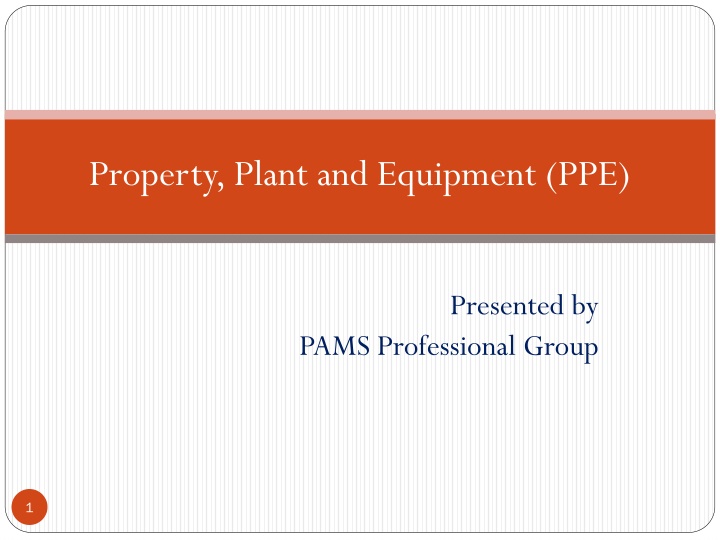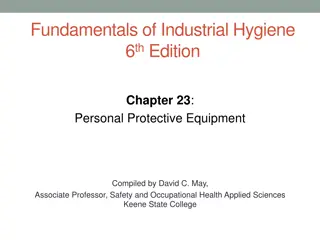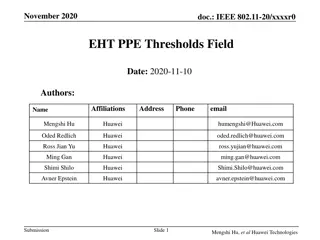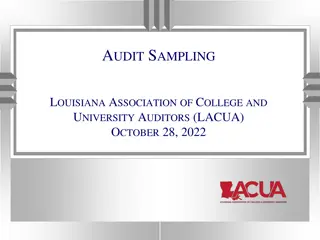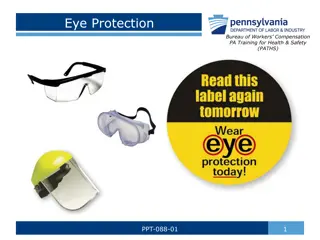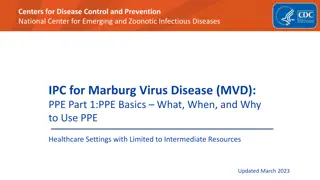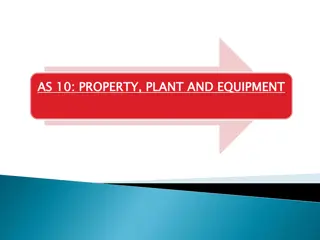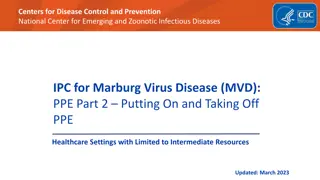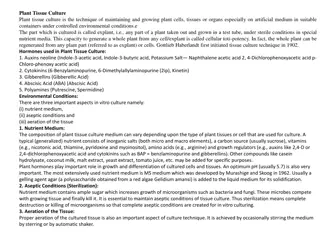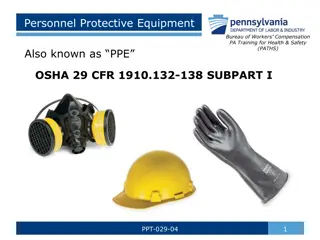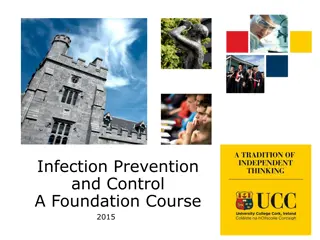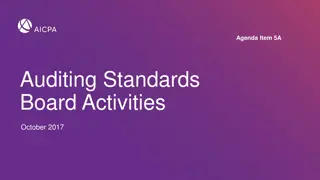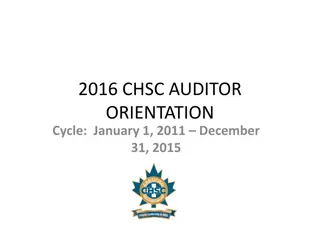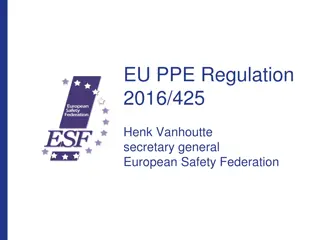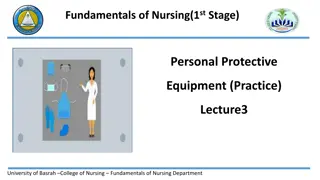Property, Plant, and Equipment (PPE) for Auditors
PPE are vital long-term assets crucial for business operations. Auditors need to assess risks related to PPE, including understanding internal controls, verifying existence and completeness, and ensuring transaction cutoffs.
Download Presentation

Please find below an Image/Link to download the presentation.
The content on the website is provided AS IS for your information and personal use only. It may not be sold, licensed, or shared on other websites without obtaining consent from the author.If you encounter any issues during the download, it is possible that the publisher has removed the file from their server.
You are allowed to download the files provided on this website for personal or commercial use, subject to the condition that they are used lawfully. All files are the property of their respective owners.
The content on the website is provided AS IS for your information and personal use only. It may not be sold, licensed, or shared on other websites without obtaining consent from the author.
E N D
Presentation Transcript
Property, Plant and Equipment (PPE) Presented by PAMS Professional Group 1
Introduction The term Property, plant and equipment in respect of such tangible items that: (a) are held for use in the production or supply of goods or services, for rental to others, or for administrative purposes; (b) are expected to be used during more than one period; (c) which are not meant for sale in the normal course of business. Property, plant, and equipment (PPE) are long-term assets vital to business operations and not easily converted into cash. Property, plant, and equipment are tangible assets, meaning they are physical in nature or can be touched. The total value of PPE can range from very low to extremely high compared to total assets. PPE normally constitute a significant portion of the total assets, particularly in a manufacturing entity. Audit of PPE, therefore, assumes considerable importance. An asset can be classified as a PPE or otherwise, depending upon the use to which it is put or intended to be put. For example, assets which are classified as PPE in one type of business may be considered as current assets in another. Similarly, the same asset may be classified differently in an entity at different points of time. 2
Features of PPE The following features of PPE have an impact on the related audit procedures: (a) By their very nature, PPE are turned over much slower than current assets which are held for sale. Normally, PPE are carried over from year to year. (b) The average unit of PPE is normally of a relatively larger rupee value. (c) Since PPE are high value items, their acquisition is normally more closely controlled. The control aspect assumes special significance where PPE are self- constructed. (d) PPE are generally accounted for once unlike other assets like stock, because of which any error would affect the financial statements permanently or at least for a significant period of time. (e) In an inflationary situation, where cost model is adopted, normally, the book values of PPE are considerably lower than their replacement values. 3
Risks associated with PPE The auditor needs to obtain an understanding of the client and its environment to consider inherent risk, including fraud risks, related to property, plant, and equipment. This includes: a. Obtaining an understanding of the internal control over property, plant, and equipment. For example, preparation of and review of capital budgets, etc. b. Assessing the risks of material misstatement and designing tests of controls and substantive procedures that cover the following aspects: i. Substantiate the existence of property, plant, and equipment. PPE may include assets that should have been derecognized following sale, other transfer of rights or abandonment. Auditor should verify title deeds, agreements or other ownership documents. ii. Establish the completeness of recorded property, plant, and equipment. Expenditure that should have been recognized as property, plant and equipment but has not been so recognized, including capitalized finance costs, failure to account for assets held under finance leases or hire purchase agreements. 4
Risks associated with PPE iii. Verify the cutoff of transactions affecting property, plant, and equipment. iv. Determine that the client has the rights to the recorded property, plant, and equipment. v. Establish the proper valuation or allocation of property, plant, and equipment and the accuracy of transactions affecting PPE. vi. Determine the correctness and appropriateness of classification of property, plant and equipment. For example, incorrect split between land and buildings or between long term and short term leaseholds. Classification may have a significant impact on the application of the accounting policies. As per relevant AS, the entities have to follow the component approach, as may be applicable. 5
Risks associated with PPE vii. Depreciation value - Depreciation may have been incorrectly calculated on account of factors such as: mechanical error; or incorrect application of accounting policy; or inappropriate assessment of remaining useful life; or inappropriate assessment of residual value; or incorrect classification of the asset. viii. Carrying cost - Where a valuation model is followed carrying amount may not reflect fair value due to factors including: failure to update valuations for current circumstances; or failure to brief valuers correctly, use of invalid assumptions or data, etc., or valuations not performed by competent personnel. ix. Value of impairment - failure to recognize impairment or reversal of impairment. x. Determine that the presentation and disclosure of PPE are appropriate. 6
Fraud Risks and Errors Some of the potential misstatements in PPE on account of frauds and errors include: (a) Purchase of an asset at an inflated price especially from a related party. (b) Wrong write-off of the asset as scrap, obsolescence, missing, donated, or destroyed. (c) Expenditures for repairs and maintenance recorded as PPE or vice versa. (d) Capitalization of expenditure which are not normally attributable to the cost of the PPE. (e) Recording of an asset purchased, which in effect has not actually been received by the entity at all. (f) Removal of an asset paid for by the entity or use of an asset of the entity for the benefit of a person other than the entity. 7
Fraud Risks and Errors Such errors and frauds could occur because of weak internal controls in the entity including: (a) Inadequate involvement of management in overseeing employees with access to cash or other assets susceptible to misappropriation. (b) PPE which are small in size, marketable, or lacking observable identification of ownership. (c) Lack of complete and timely verification and reconciliations of assets. (d) Inadequate physical safeguards over PPE. (e) The misuse of the entity s assets by an employee. (f) Using an entity s assets for personal use (for example, using the entity s assets as collateral for a personal loan or a loan to a related party). (g) The asset is intentionally sold below fair market value. 8
Risk Assessment Procedure The auditor should perform risk assessment procedures to provide a basis for the identification and assessment of risks of material misstatements. These would include: (a) Inquiries of management and others within the entity to identify the risks. For example, control procedures, entity s objectives and strategies, incentive policies, etc. (b) Analytical procedures, for example, Ratios, etc. (c) Observation and inspection of the entity s premises and plant facilities. An auditor should review the system of internal controls relating to PPE, particularly the following: (a) Control over expenditure incurred on PPE acquired or self-constructed-An effective method of exercising this control is capital budgeting, which, apart from ensuring proper authorization of the expenditure incurred, also shows, in general, how effectively such expenditure is being controlled through periodical comparisons of actuals with budgeted figures. It also ensures that amounts expended do not exceed the amounts authorized, and controls allocation of expenditure between capital and revenue in the case of self constructed assets. 9
Risk Assessment Procedure (b) Accountability and utilization controls- Accountability over each PPE (or each class or component of PPE) is established, among other things, by maintaining appropriate records. This facilitates control over custodianship of such assets, for example, physical verification by the management or establishment of procedures relating to disposal of PPE. On the other hand, utilization controls ensure that the individual PPE have been properly used for meeting the objectives of the entity. (c) Information controls-These controls ensure that reliable information is available for calculating and allocating depreciation, recording disposals or retirements, preparing tax returns, establishing the amount of insurance coverage, filing insurance claims, controlling repairs and maintenance charges or expenses incurred for inspection to assess the condition of the asset, replacement cost of specific parts, useful life of assets or specific parts, e.g., specified number of hours of use, etc. 10
Risk Assessment Procedure (d) Safeguarding of assets-Thesecontrols ensure that the assets owned by the entity are safeguarded and any loss on damage/destruction of such assets are made good, through for example, insurance of assets, warranties, etc. The entity may have a process by which responsibility to safeguard the assets could be identified to specific personnel. Verification of PPE consists of examination of related records and physical verification. The auditor should, normally, verify the records with reference to the documentary evidence and by evaluation of internal controls. Physical verification of PPE is primarily the responsibility of the management. The auditor must also consider the appropriateness of the accounting policies, including policies for determining which costs are capitalized, whether a cost or valuation model is followed and depreciation (including assessment of residual values) appropriately calculated. The auditor should ensure that the entity has capitalized the assets as per the component approach, whereby a component or part of an asset which is significant in value compared to the total value of the asset or the useful life of which is different from that of the asset, has to be capitalized separately. The opening balances of the existing PPE should be verified from records such as the schedule of PPE, ledger or register balances. The auditor would also need to obtain summary of changes to PPE and reconcile the same to the ledgers. 11
Addition to PPE Acquisition of new PPE and improvements to the existing ones should be verified with reference to supporting documents such as orders, invoices, receiving reports and title deeds and applicable customs or excise documents. Due care needs to be taken when the purchase is from a related party. The auditor may employ procedures such as possible comparative prices prevalent in a ready market, evaluation, justification and approvals for the purchase. Self-constructed PPE and improvements thereto should be verified with reference to the supporting documents such as contractors' bills, work-order records, installation certification, completion certificates and independent confirmation of the work performed. The auditor should make appropriate enquiries and examine lease contracts to provide evidence that PPE acquired under finance leases or hire purchase agreements have been properly capitalized. In respect of the additions to PPE during the year, the supporting documentation and information for the date on which the asset was put to use / was ready to use is required to be verified. 12
Addition to PPE Assets acquired in exchange for a non monetary asset(s) should be verified with reference to the supporting documents for the commercial substance of the transaction (cash flows from the assets acquired against those given up) and the value of the asset given up. The auditor should review expense accounts (e.g., Repairs and Renewals) to ascertain that new capital assets and improvements have not been included therein. Verify that acquisition price of fixed asset acquired during the year includes expenditure that is directly attributable to the acquisition of the items and booked net of GST Credit. Effect on acquisition price of fixed asset acquired from country outside India in foreign currency as per Ind AS-21- Acconnting for the effect of changes in foreign exchange rates . Verify installation date with Installation certificate to ensure accuracy of depreciation. Verify that fixed asset register has been properly updated head wise and location wise. 13
Ownership of PPE The ownership of assets, like land and buildings, may be verified by examining the title deeds. In case the title deeds are held by other persons, such as solicitors or bankers, confirmation should be, at least where significant, obtained directly by the auditors through a request signed by the client. The auditor would also need to perform procedures to obtain corroborating evidence that the client actually possesses the rights associated with the assets under consideration. For example, the fact that the cash flows or economic benefits associated with it are actually accruing to the client. Verity the Title deed in respect of free hold land. Verify whether property is mortgage against any borrowing by checking the confirmation received from bank where property held as mortgage is specified by the bank. Verification of Pledge against borrowings through MCA and CHG Forms. 14
Deletions of PPE Where PPE have been written-off or fully depreciated in the year of acquisition/construction, the auditor should examine whether these were recorded in the PPE register before being written-off or depreciated. In respect of PPE retired, i.e., destroyed, held for sale, scrapped or sold, the auditor needs to examine the following aspects, inter alia: (a) whether the retirements have been properly authorized and appropriate procedures for invitation of quotations have been followed wherever applicable; (b) whether the assets and depreciation accounts have been properly adjusted; (c) whether the sale proceeds, if any, have been fully accounted for; and (d) whether the resulting gains or losses, if material, have been properly adjusted and disclosed in the Profit and Loss Account. (e) GST has properly calculated and accounted on disposal of PPE. 15
Deletions of PPE It is possible that certain assets destroyed, scrapped or sold during the year have not been recorded. The auditor may use the following procedures to ascertain such omissions: (a) Review work orders/physical verification reports to trace any indicated retirements. (b) Examine major additions to ascertain whether they represent additional facilities or replacement of old assets, which may have been retired. (c) make enquiries of key management and supervisory personnel. (d) Obtain a certificate from a senior official and/or departmental managers that all assets scrapped, destroyed or sold have been recorded in the books. The auditor would also need to review the board minutes and other correspondence for indications of significant assets acquisitions, disposals or retirements. Where there has been a change of use, the auditor would need to consider whether this gives rise to a need to change classification of the asset (e.g., to inventory), assets held for sale, investment property, etc. 16
Physical Verification It is the responsibility of the management to carry out physical verification of PPE at appropriate intervals in order to ensure that they are in existence. However, the auditor should satisfy himself that such verification was done by observing the verification being conducted by the management wherever possible and by examining the written instructions issued to the staff by the management and the relevant working papers. The auditor should also satisfy himself that the persons conducting the verification, whether the employees of the entity or outside experts have the necessary competence. The auditor should examine whether the method of verification was reasonable in the circumstances relating to each asset. For example, in the case of certain process industries, verification by direct physical check may not be possible in the case of assets which are in continuous use or which are concealed within larger units. SA 501, Audit Evidence Specific Considerations for Selected Items contain principles related to the auditor s responsibilities and procedures in respect of attendance at physical inventory counting undertaken by the management. 17
Physical Verification It would not be realistic to expect the management to suspend manufacturing operations for conducting a physical verification of the PPE, unless there are compelling reasons which would justify such an extreme procedure. In such cases, indirect evidence of the existence of the assets may suffice. For example, the very fact that an oil refinery is producing at normal levels of efficiency may be sufficient to indicate the existence of the various process units even where each such unit cannot be verified by physical or visual inspection. It may not be necessary to verify assets like building by measurement except where there is evidence of alteration/demolition. At the same time, in view of the possibility of encroachment, adverse possession, etc., it may be necessary for a survey to be made periodically of open land. Where the PPE can be moved and where verification of all assets cannot be conducted at the same time, they should be marked with distinctive numbers. The auditor should apply appropriate emphasis on the verification of assets by the management of the assets which are outside the premises of the company, with third parties. 18
Physical Verification This may be by way of a process of physical verification by the management or by way of obtaining confirmation from the third party holding the asset, depending on the management s risk assessment of such assets and the materiality of such assets. The auditor should examine whether the frequency of verification was reasonable in the circumstances of each case. Where the assets are few and can be easily verified, an annual verification may be considered as reasonable. However, where the assets are numerous and difficult to verify, verification, say, once every three years by rotation - so that all assets are verified at least once in every three years may be sufficient. The auditor should test check the records of PPE with the physical verification reports. He should examine whether discrepancies noticed on physical verification have been properly dealt with. In this regard the auditor should use his judgement as to whether having regard to the circumstances, the discrepancy is material enough to warrant an adjustment in the accounts and/ the internal control system. or modification in 19
Recognition The auditor should ensure that the cost of an item of PPE is recognized as an asset only when the costs have been reliably measured and it has been ascertained by the management that future economic benefits will flow to the entity. The auditor should also verify that the entity has recognized a fixed asset in accordance with the generally accepted accounting principles applicable to the entity. Capital work in progress: The auditor should verify that PPE under construction are recognized as capital work in progress until such time they are ready for intended use. The auditor should also verify that only those costs that could be capitalized are included under work in progress. Component approach: The auditor should verify that the relevant PPE are capitalized as components where the useful life of the components significantly vary from the useful life of the entire asset (e.g., Cost of relining a furnace, aircraft seats which require replacement at regular intervals and, thus, have a varying useful life from the rest of the furnace or aircraft, respectively). Each major part of the item of PPE with a cost that is significant in relation to the total cost of the item is depreciated 20 separately.
Government Grants When the entity acquires land or other fixed assets as government grants at concessional rates, then the entity has to account for such assets at the acquisition cost. In case the asset is acquired free of cost, it should be accounted at nominal value. The grant can be shown as a deduction from the gross value of assets or the asset can be shown in the balance sheet at the net value. Ensure that Government grant received in respect of acquisition of PPE has been recognized & disclosure as per AS 20. 21
Depreciation Verify that, depreciation have been calculated based on life of assets specified in Schedule II of the companies Act, 2013. The auditor should test check the calculations of depreciation and the total depreciation arrived at should be compared with that of the preceding years to identify reasons for variations. The auditor should review the depreciation method applied to the asset at least at the end of each financial year to confirm that the depreciation charge reflects the usage. A change in the method of depreciation should be treated appropriately as a change in an accounting estimate. The auditor must verify that those assets under construction or installation are not depreciated until such time they are ready for intended use but these should be tested for impairment, if any. The auditor should ensure that the management has reviewed the useful life and the residual value of the asset at least annually. The useful life is, ordinarily, estimated based on the future economic benefits embodied in the asset or such other factors prescribed by the Standard or the asset management policy of the entity. 22
Impairment An asset is impaired when the carrying amount of the asset exceeds its recoverable amount. If the recoverable amount of an asset is less than its carrying amount, the carrying amount of the asset should be reduced to its recoverable amount. Verify whether impairment indicator exist or not ,if exist then impairment testing should be performed as per AS. The auditor should enquire whether any compensation is receivable from third parties for items of PPE which are impaired, lost or given up and credit the same to the Profit & Loss Account when the amount becomes receivable. 23
Revaluation Revaluation of PPE implies restatement of their book values on the basis of systematic scientific appraisal which would include ascertainment of working condition of each unit of PPE, technical estimates of future working life and the possibility of obsolescence. This is done where the fair value of the asset can be reliably measured. For example, an expert may be used for valuation of land and buildings or plant and machinery, such an appraisal is usually made by independent and qualified persons such as engineers, architects, etc. To the extent possible, the auditor should examine these appraisals. As long as the appraisals appear reasonable and based on adequate facts, he is entitled to accept the revaluation made by the experts. Where valuation is performed internally, the auditor should consider the basis on which it was done, the adequacy of the evidence obtained to support the valuation and the overall reasonableness of the result. The auditor must also satisfy himself that the frequency of revaluation is adequate and appropriate. 24
Disclosure The auditor should verify that the entity has made relevant disclosures for PPE (or class of PPE) on depreciation methods, measurement bases, details of additions and deletions, the existence of rights and restrictions, carrying amount during the course of construction, contractual commitments, impairment of assets, revaluation of assets, etc. Assets under Lease shall be separately specified under each class of assets A reconciliation of the gross and net carrying amounts of PPE at the beginning and end of the reporting period showing additions, disposals, acquisitions through business combinations, other adjustments and impairment losses/reversals shall be disclosed separately. In Case of Foreign Operation- the net exchange differences arising on the translation of the financial statements from the functional currency into a different presentation currency, including the translation of a foreign operation into the presentation currency of the reporting entity; and other changes ,if any Estimated amount of contracts remaining to be executed on capital account and not provided for(Capital commitment) Para 8.8.7.3 schedule III 25
Cross linking in Financials Balance Sheet: 1) Property, Plant & Equipment Note 2) Capital Advances 3) Investment property (if land is rented) 4). Borrowings taken on mortgage of property. Cash Flow: 1) Operating Activity 2) Investing Activity Profit & Loss: 1) Profit /Loss on Disposal of asset. 2) Rate & Taxes (Property Tax, etc.) 26
Cross linking in Financials Other Notes to Account: 1) Asset Hypothecation Charge Note 2) Contingent liability and other commitment note(capital commitment) 3) Income Tax Computation Caro Reporting: Caro 2016 clause 3 related to fixed assets. Income Tax Computation: 1) Disallowance of impairment loss 27
Thank You so much for giving your precious time. PAMS Professional Group 28
